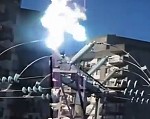|
 High voltage. Low voltage.
We hear the term used often, but it would be good to have a definitive listing of what voltage
levels qualify for which levels. The table below lists some typical names and the corresponding
voltage levels. The video clip at the left appeared as a Cool Pic on RF Cafe a year or so
ago, and the one on the right was recently found. Both are awesome. High voltage. Low voltage.
We hear the term used often, but it would be good to have a definitive listing of what voltage
levels qualify for which levels. The table below lists some typical names and the corresponding
voltage levels. The video clip at the left appeared as a Cool Pic on RF Cafe a year or so
ago, and the one on the right was recently found. Both are awesome.
For human electrocution levels, please click
here.
| Safety Extra-Low1 |
≤42.2 Vac pk, ≤60 Vdc |
Considered "safe" for touching (although never recommended). Protected to "guarantee"
voltage will never rise above these levels, even under a fault condition. Double insulated. |
| Extra-Low1 |
≤42.2 Vac pk, ≤60 Vdc |
Non-touchable, but considered safe due to insulation from hazardous voltages. |
| Low2 |
≤1 kVac |
Considered hazardous. These level are found in common residential and commercial equipment
installations. |
| Medium3 |
>1 kVac to 100 kVac |
Very hazardous. Residential and small commercial transformers, both on poles and on the
ground. |
| High3 |
≥100 kVac to ≤230 kVac |
Very hazardous. Found in transmission grid systems including substations. |
| Extra-High4 |
>230 kVac to ≤800 kVac |
Extremely hazardous, even at a distance. Transmission systems between substations and
power generation. |
| Ultra-High4 |
>800 kVac to 2 MVac |
Extremely hazardous, even at a great distance. Transmission systems between substations
and power generation. |
References:1: IEC 60950-1 2: NEC-NFPA 70 low voltage = 600 V, ANSI/IEEE low voltage
= 1 kVac, EU's Low Voltage Directive = 50 V to 1 kVac & 75 to 1.5 kVdc 3: ANSI C84.1 &
IEEE 100 4: IEEE 1312 & IEEE 100
|
 High voltage. Low voltage.
We hear the term used often, but it would be good to have a definitive listing of what voltage
levels qualify for which levels. The table below lists some typical names and the corresponding
voltage levels. The video clip at the left appeared as a Cool Pic on RF Cafe a year or so
ago, and the one on the right was recently found. Both are awesome.
High voltage. Low voltage.
We hear the term used often, but it would be good to have a definitive listing of what voltage
levels qualify for which levels. The table below lists some typical names and the corresponding
voltage levels. The video clip at the left appeared as a Cool Pic on RF Cafe a year or so
ago, and the one on the right was recently found. Both are awesome.